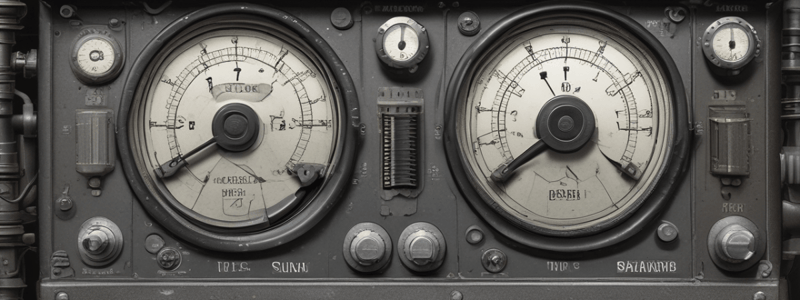Podcast
Questions and Answers
What is the purpose of a shunt resistor in an ammeter?
What is the purpose of a shunt resistor in an ammeter?
- To bypass current that exceeds the limitation of the meter movement (correct)
- To increase the current sensitivity of the meter movement
- To increase the resistance of the meter
- To decrease the voltage drop across the meter
What is the current sensitivity of a standard d'Arsonval meter movement?
What is the current sensitivity of a standard d'Arsonval meter movement?
- 100 mA
- 10 mA
- 1 mA (correct)
- 0.1 mA
What is the resistance of the meter movement in the example given?
What is the resistance of the meter movement in the example given?
- 500 Ω
- 10 Ω
- 50 Ω (correct)
- 100 Ω
What is the current that the shunt resistor should carry in the example given?
What is the current that the shunt resistor should carry in the example given?
What is the relationship between the voltage drop across the shunt resistor and the voltage drop across the meter resistance?
What is the relationship between the voltage drop across the shunt resistor and the voltage drop across the meter resistance?
What is the equation that relates the shunt resistance and the meter resistance?
What is the equation that relates the shunt resistance and the meter resistance?
What is the calculated value of the shunt resistance in the example given?
What is the calculated value of the shunt resistance in the example given?
Where can shunts be located?
Where can shunts be located?
What is necessary for an ohmmeter to operate?
What is necessary for an ohmmeter to operate?
What is the purpose of the ranging resistors in an ohmmeter?
What is the purpose of the ranging resistors in an ohmmeter?
Why is the ohmmeter scale uneven and reversed?
Why is the ohmmeter scale uneven and reversed?
What is the relationship between the resistance being measured and the meter deflection?
What is the relationship between the resistance being measured and the meter deflection?
What is the purpose of shorting the test leads of the ohmmeter together?
What is the purpose of shorting the test leads of the ohmmeter together?
What is the main purpose of a multiplier in a voltmeter design?
What is the main purpose of a multiplier in a voltmeter design?
What type of meter movement is commonly used in analogue voltmeters?
What type of meter movement is commonly used in analogue voltmeters?
What happens to the meter current when the test leads are shorted?
What happens to the meter current when the test leads are shorted?
What is the purpose of a multi-pole switch in a multi-range voltmeter?
What is the purpose of a multi-pole switch in a multi-range voltmeter?
What is the position of the pointer on the ohms scale when the leads are shorted?
What is the position of the pointer on the ohms scale when the leads are shorted?
What is the full-scale deflection current rating of a sensitive D'Arsonval meter movement?
What is the full-scale deflection current rating of a sensitive D'Arsonval meter movement?
What is the purpose of the moving coil in an ohmmeter?
What is the purpose of the moving coil in an ohmmeter?
What is the main difference between analogue and digital voltmeters?
What is the main difference between analogue and digital voltmeters?
What is the internal wire resistance of a D'Arsonval meter movement?
What is the internal wire resistance of a D'Arsonval meter movement?
What is the purpose of a multiplier resistor in a multi-range voltmeter?
What is the purpose of a multiplier resistor in a multi-range voltmeter?
What is the primary purpose of a static discharger in an aircraft?
What is the primary purpose of a static discharger in an aircraft?
What is the typical resistance range of a serviceable static discharger?
What is the typical resistance range of a serviceable static discharger?
What is the voltage range of a voltmeter that uses a D'Arsonval meter movement with a full-scale deflection current rating of 50 µA and an internal wire resistance of 1000 Ω?
What is the voltage range of a voltmeter that uses a D'Arsonval meter movement with a full-scale deflection current rating of 50 µA and an internal wire resistance of 1000 Ω?
What is the purpose of removing corrosion protection from the sleeve before testing a static discharger?
What is the purpose of removing corrosion protection from the sleeve before testing a static discharger?
What type of meter movement is commonly used in multimeters?
What type of meter movement is commonly used in multimeters?
What is the name 'multimeter' derived from?
What is the name 'multimeter' derived from?
What type of measurement is possible with a multimeter that has a built-in rectifier?
What type of measurement is possible with a multimeter that has a built-in rectifier?
What is the common abbreviation for a digital multimeter?
What is the common abbreviation for a digital multimeter?
What is the primary function of an aircraft technician's most common measuring instrument?
What is the primary function of an aircraft technician's most common measuring instrument?
What type of magnetic field does a meter current transformer have?
What type of magnetic field does a meter current transformer have?
What is the advantage of using voltage transformers in voltmeters?
What is the advantage of using voltage transformers in voltmeters?
What is the function of the pivoted limb in the current transformer?
What is the function of the pivoted limb in the current transformer?
What is the purpose of the trigger in the "clip-on" type of ac ammeter?
What is the purpose of the trigger in the "clip-on" type of ac ammeter?
What type of instrument is used in the "clip-on" type of ac ammeter?
What type of instrument is used in the "clip-on" type of ac ammeter?
What is the advantage of using a current transformer in an ammeter?
What is the advantage of using a current transformer in an ammeter?
How is the current in a conductor measured using the "clip-on" type of ac ammeter?
How is the current in a conductor measured using the "clip-on" type of ac ammeter?
Flashcards are hidden until you start studying
Study Notes
Ammeter Shunt Resistance
- A standard d'Arsonval meter movement has a current sensitivity of 1 mA and a resistance of 50 Ω.
- To measure more than 1 mA, a simple shunt resistor is required to bypass excess current.
- The shunt resistor carries the excess current, while the remaining 1 mA passes through the meter.
- The shunt resistance and meter resistance are in parallel, resulting in the same voltage drop across both.
Ammeter Shunt Calculation
- Using Ohm's law, the shunt resistance can be calculated as: RSH = (IM × RM) / I.SH
- Example: RSH = (1 mA × 50 Ω) / 9 mA = 5.56 Ω
Shunt Location
- Shunts can be located in the ammeter case or externally.
- Remotely located external shunts are used in high-current cables, such as generator feeder lines.
Voltmeter Design
- D'Arsonval meter movements are sensitive devices with full-scale deflection current ratings as low as 50 µA.
- To build voltmeters with practical scales, a multiplier (RS) is connected in series with the meter movement.
- The multiplier extends the voltage range of the meter movement and limits the current through the meter movement.
Multi-Range Voltmeter
- A multi-range voltmeter uses a multi-pole switch and several multiplier resistors, each sized for a particular voltage range.
Ohmmeter Design
- An ohmmeter uses an internal source of voltage to create the necessary current to operate the movement.
- The ohmmeter has ranging resistors to allow the right amount of current through the movement at any given resistance.
- The ohmmeter scale is uneven and reversed compared to the voltmeter and ammeter scales due to the inverse relationship of Ohm's law formula: R = E/I.
Multimeter
- A multimeter is a DC ammeter, DC voltmeter, AC ammeter, AC voltmeter, and ohmmeter in one package.
- Multimeters can be analogue or digital (DMM or DVOM).
- Most multimeters use a d'Arsonval meter movement and have a built-in rectifier for AC measurement.
Transformer/Rectifier Meters (Clamp Meter)
- A transformer/rectifier meter uses a voltage transformer to adapt moving-coil instruments for AC measurement.
- The output of a transformer is a function of the input and can be used to supplement series resistors in voltmeters or current transformers in ammeters.
- The "clip-on" type of AC ammeter uses a current transformer to measure current in a conductor by enclosing the conductor at any convenient point.
Studying That Suits You
Use AI to generate personalized quizzes and flashcards to suit your learning preferences.




